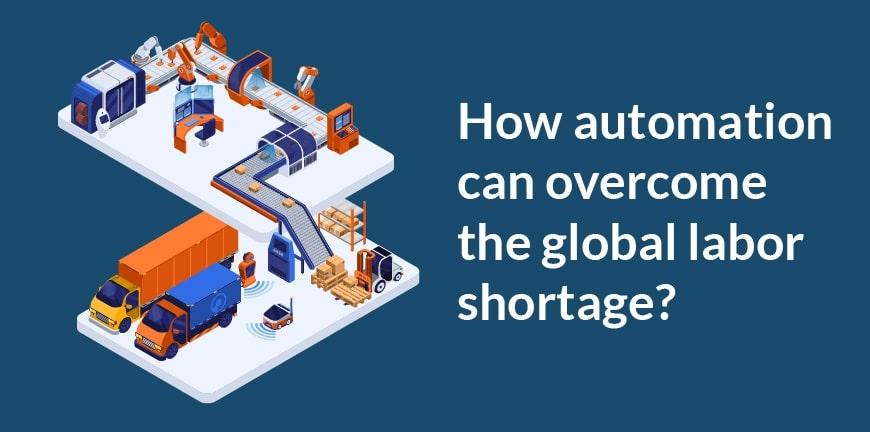
What is a Managed Service Provider?
15/07/2023
6 Challenges Before AI Can Rebuild Healthcare
17/07/2023- Consequences of Shortage of Skilled Labour
- Automation Aiding us in Overcoming the Global Shortage
- Automation can Amplify the Existing Workforce.
- Automation can Augment Human Capabilities in Labour Intensive Roles.
- Augmented Reality Increases Visibility, Facilitating Oversight Streamlining.
- High Tech Wearables Can Elevate Safety or Workers.
- Automation can Create New, Varied Categories of Work.
- Automation can Help. Embrace it.
The worker shortage is a growing problem across the globe, especially in mature and developing economies. Whether it is healthcare professionals, plumbers, airport staff, soldiers, there is a huge dip in the availability of skilled labour force across all fields and industries.
What is more baffling is that the number of people leaving their jobs are far more than ones entering it.
According to data published in 2021 by the U.S. Bureau of Labor Statistics, 65% of workers are aged 35 and older, with 21% above age 55. The US Chamber of commerce estimated that there are 3 million fewer Americans working than compared to in 2020. While there has been an increase in the labour force from the past few years, it still presents us with a staggering number of 5.7 million people unemployed to fill the 10 million and over job openings.
A global decline in birthrates is already affecting other industries and trades, especially in countries such as Italy and Japan, where the population of aging workers drastically outweighs those entering the market.
In the past, the labour shortage problem faced by countries that were developed economies, was dealt by off shoring manufacturing to lower-cost countries like China, Bangladesh, Taiwan, and India. But in recent times even these so-called manufacturing powerhouses are facing labour shortage.
In Thailand, there is a requirement of over 500,000 migrant workers from neighbouring countries to fill roles in food processing, construction, and agriculture. Due to the recent problems faced by Ukrainian immigrants, Poland is also facing pressure as they are kept away from working in Polish factories.
Consequences of Shortage of Skilled Labour
In 2019, the Census of fatal Occupational Injuries reported 1102 construction worker fatalities. Several respondents reported that the shortage of skilled labour saw more delays in project completion, higher project costs and a negative impact on workers’ health and safety. This point is especially noteworthy.
80% of contractors and developers have noted concern at the risks to health and safety posed by untrained laborers joining the workforce—and rightly so. Inexperienced workers are disproportionately subjected to injuries, as studies show that 60% of construction injury cases happen during the first year of employment. And in an increasingly competitive marketplace, the financial risk posed by the employment of unseasoned workers is not at all ideal.
Automation Aiding us in Overcoming the Global Shortage
With automation, seasoned human workers are empowered to use their intrinsic knowledge of production best practices to help the manufacturing plant well beyond repetitive or tedious tasks. Refocusing skilled workers on more strategic tasks can create critical competitive advantages for manufacturers, especially as all competitors worldwide struggle to find and retain talent.
Automation can Amplify the Existing Workforce.
First things first. The robots are here to help and not steal our jobs. On the contrary, the effective use of them will help create more jobs in the future increasing employment opportunities for our future generations. We will tell you how in a bit.
It is time to accept that automation in Industries is not just necessary but necessary in today’s time. We cannot keep up with today’s dynamic business needs if we keep pulling at the old ideas. The time is now to shift our approach and lean towards automation to address the rapidly growing skilled labour shortage.
The best solution to address the labour concern is by empowering and upskilling the talent available to amplify their work. How do you do that? By engaging in innovative technology and automation.
Across various industries, automation, the industrial internet of things (IIoT), virtual and augmented reality (AR), and machines equipped with artificial intelligence effectively enable workers to perform better than they could have ever imagined.
Automation can Augment Human Capabilities in Labour Intensive Roles.
Construction work is tedious, involves physically intense work and can lead to injuries in a fraction of a second if there is a miss. Automation can replace most of these stressful tasks. Whether it is bricklaying or rebar tying, replacing humans with robots can help avoid injury. Additionally, with a minimum training, the automation, supervision, and operation of the machinery can be taught to the staff, scheduling opportunities, and maximizing work output.
Augmented Reality Increases Visibility, Facilitating Oversight Streamlining.
Imagine gaining complete access to the progress of your project and be able to visit, inspect and gain insight, here is the twist! Virtually! Technology enabled solutions can make this happen in a blink of an eye.
Workers with extensive knowledge and valuable experience do not have to get their hands or feet dirty and can leverage AR, to shift to remote monitoring of multiple projects simultaneously making most of their time.
High Tech Wearables Can Elevate Safety or Workers.
Smart Hard Hats, Construction Smartwatches, Exoskeletons, Bodywear and wearable sensors, Smart Boots etc. sound like something out of a DC or Marvel series, right? Get this, they are not fictious, they are real. Thanks to the advancement in technology, these high-tech wearables are more than just fancy equipment. They can help prevent even the largest casualties. From alerting workers to avoiding hazards caused by dangerous equipment to monitoring brain waves, HiFi tech can help support the health of labour workers reducing fatalities.
Automation can Create New, Varied Categories of Work.
The use of AI (Artificial Intelligence) can help transform your workflow and efficiency before you even begin working on it. You can model your project in 4D, finding innovative ways to build, manage and schedule project resources. Digitizing project data can help unlock new efficiencies, creating new, appealing opportunities for the new generation of workers interested in thriving in the construction tech.
World Economic Forum estimates that by 2025, technologies, such as Artificial Intelligence and automation, will create at least 12 million more jobs than they eliminate.
Jobs that are expected to face a growing demand include-
- Data analysts and data scientists
- AI and machine learning specialists
- Big data specialists
- Digital marketing and strategy specialists
- Process automation specialists
- Business development professionals
- Digital transformation specialists
- Information security analysts
- Software and applications developers
- Internet of things specialists
Automation can Help. Embrace it.
Henry Ford could not have conceived of the need for a software engineer any more than an 18th-century farmer could have conceived of a diesel mechanic. We know you are worried that the world of work is changing, and Jobs of the future will not look like jobs of the past. But that is ok. Trusting in the superpowers created by automation will drive innovation and efficiency, resulting in more opportunities for the workforce of tomorrow.
Contact Us For Business Enquiry

Rajkumar Shanmugam
Rajkumar Shanmugam is the Head of HR at ALP Consulting, bringing over 19 years of comprehensive HR leadership experience across India and international markets. His expertise spans talent acquisition, employee relations, performance management, compliance, and HR transformation. Rajkumar has a proven track record of driving people-centric initiatives, enhancing workplace culture, and aligning HR strategy with business goals. With extensive experience in US staffing operations and global mobility, he continues to lead organizational excellence through innovation and employee engagement.




